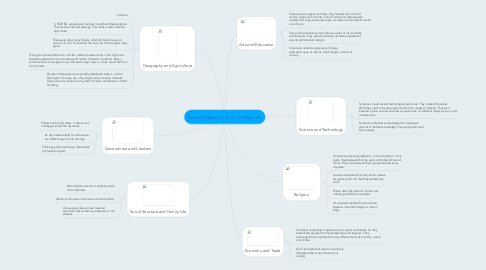Seven Aspects of a Civilization
by Annika Weber

1. Arts and Education
1.1. Sumerians were great architects, they learned how to build arches, ramps and columns. Some Sumerian sculptures were created with large, wide-open eyes, as well as small objects carved out of ivory.
1.2. Some of the Sumerians most famous works of art was there cylinder seals. They were small stone cylinders engraved all around with detailed designs.
1.3. Sumerians created sculptures with large, wide-open eyes, as well as small objects carved out of ivory.
2. Science and Technology
2.1. Sumerians made several technological advances. They created the wheel, which they used to create pottery and build a variety of vehicles. They also invented a plow and learned how to use bronze for different things such as tools and weapons.
2.2. Sumerians collected and cataloged an impressive amount of medical knowledge. They even performed basic surgery.
3. Social Structure and Family Life
3.1. Men held dominance in political power and made laws.
3.2. Women took care of the home and the children.
3.3. A few upper-class women received education and served as priestesses in the temples.
4. Economy and Trade
4.1. Sumerians lacked raw materials such as wood and metals. So they traded with people from Southwest Asia and beyond. They exchanged woven textiles for many different items like metals, stones, and timber.
4.2. All of the trade that went on eventually developed their social hierarchy or ranking.
5. Religion
5.1. Sumerians practiced polytheism, or the worship of many gods. They believed that the gods controlled all natural forces. They also believed that a god protected every city-state.
5.2. Sumerians believed that they had to please the gods and to do that they worked very hard.
5.3. Priests held high status In Sumer and initially governed the city-state.
5.4. As city-states battled for dominance, however rule chiefs began to rule as kings.
6. Geography and Agriculture
6.1. Sumeria
6.2. In 5500 BC, people were farming in southern Mesopotamia. The land was flat and swampy. This made it well suited for agriculture.
6.3. There were often many floods, which left behind a good amount of silt. This enriched the soil, and farmers grew many grains.
6.4. This region received little rain, and this made the water levels in the Tigris and Euphrates depend on snow melting and rainfall in distant mountains. Rivers could overflow at any given time, and wash away crops or, crops would die from hot summers.
6.5. People in Mesopotamia eventually developed ways to control their water. One way was, they dug basins to restore rainwater. They also built canals to carry water to fields, and dikes to control flooding.
7. Government and Leaders
7.1. Priests held a high status in Sumer and initially governed the city-states.
7.2. As city-states battled for dominance, war chiefs began to rule as kings.
7.3. The kings performed many ceremonies to please the gods.


